Michel Gybels for Time Travel Rome
The ruins of the ancient city of Glanum in the South of France Provence region are a popular destination on the tourist route that leads from Avignon to Arles, passing the site of Les Baux and the medieval abbey of Montmajour.
Until the beginning of the 20th century, however, only two well preserved monuments, a mausoleum and an arch, known as “Les Antiques”, signalled Glanum’s location and its past glory.
Situated at the meeting point of the wild Alpilles hills and the gentle plain, the secrets of this Gallo-Greek and Gallo-Roman city were uncovered by painstaking archaeological work.
Thanks to the research of the archaeologists Pierre de Brun and Henri Rolland, Glanum, which is scarcely mentioned by classical authors, has now been given a posthumous future and is today one of the best-known and most spectacular classical sites in France.
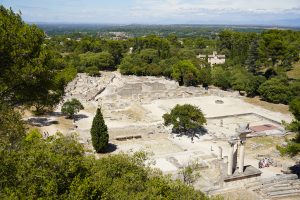
The site of Glanum and the surrounding valley. Photo by TimeTravelRome.
The Iron Age Sanctuary of the Salluvii (6th-2nd centuries BC)
At the northern end of the narrow gorge of Notre-Dame-de-Laval, which today connects Saint-Rémy-de-Provence with Maussane-les-Alpilles, a permanent spring has been occupied since Neolithic times and was surrounded by an adjoining Salluvian settlement, Glanum, during the Iron Age from the 6th-2nd century BCE.
The healing waters of that spring gave rise to a Celto-Ligurian civilization, which exceptionally at Glanum, was able to accept and profit from the cultural fashions of the Hellenistic Mediterranean world long before it had to conform to Roman directives.
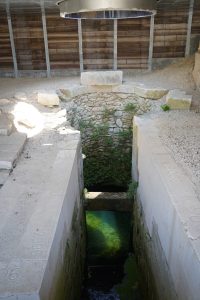
The so-called Dromos Spring”, which was at the origin of the ancient Glanum. Photo by TimeTravelRome.
Among the offerings thrown into the bassin of the spring and the rocky cave are painted and engraved stone steles, pottery and coins. A Celtic god, Glanis, and his beneficent companions, the “Glanic Mothers”, were believed to inhabit these crystalline healing waters.
At the end of the 2nd or the beginning of the 1st century BCE, a first rampart was complemented by a new wall that doubled the enclosed surface. Some remains of towers have been found. This second fortification might be related to the Germanic invasions (Teutons and Ambrons). They were defeated by the Roman general Marius near Aix-en-Provence in 102 BCE after three years of campaigning, military preparations and civil engineering.
The Golden Age and Roman Conquest (2nd c. BC – early 1st c. BCE)
The Celtic character of Glanum is obvious. However, the proximity of the Greek city of Marseille (Massalia), founded by the Phocaeans in 600 BCE, encouraged contacts between the Rhône delta and Mediterranean civilisations. The powerful aristocratic and warrior families were open to Hellenistic contributions and this gave rise to a new cultural identity, the so-called Gallo-Greek culture, of which Glanum is the finest example known to us.
But increasing tension with Marseille incited the Greeks to ask Rome for help. The Salluvii were defeated by the Roman consul Marcus Fulvius Flaccus in 125 BCE, and again by Gaius Sextius Calvinus in the following year, who also founded Aquae Sextiae (Aix-en-Provence) in 122 BCE.
Glanum’s monuments were destroyed but far from admitting defeat, the local dignitaries started a remarkable building boom, covering Glanum’s narrow valleys with even more impressive houses and public monuments. At the peak of its prosperity, based on the prestige of the healing sanctuary, the city issued silver coins in its own name (Glanikon).
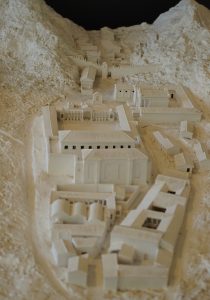
Glanum at the time of the Empire. Reconstruction in the Museum at the site. Photo by TimeTravelRome.
This Golden Age was brought to an abrupt end by a final revolt of the Salluvii in 90 BCE, which was immediately subdued by the Roman consul Caecilius. Most of Glanum’s monuments were demolished and the city took a long time to recover from its ruined state. The first half of the 1st century BCE was a difficult period for the whole of the Provincia (Southern Gaul), in particular Pompey’s bloody expedition in 77 BCE and the regime of the vicious praetor Fonteius.
Glanum, a Prosperous City in Narbonensis (1st c. BC – 3rd c. AD)
In 49 BCE Gaius Julius Caesar seized Marseille and on its confiscated territory he founded the colony of Arelate (Arles) in 45 BCE. Whereas many, like Glanum, were granted Latin rights as oppidum Latinum, only a few were elevated to the more prestigious rank of colony. When Octavian became the emperor Augustus in 27 BCE, he created the province of Narbonensis, which was administered by the Senate from 22 BCE onwards.
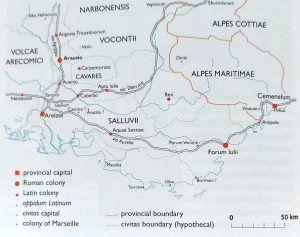
Map of cities in southeast Gaul at the beginning of the Empire. Photo by Michel Gybels.
The status of oppidum Latinum allowed Glanum’s aristocracy to acquire the prestigious Roman citizenship by serving as local magistrates, giving them the full civic and political rights of Rome.
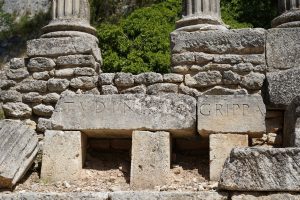
Basement of the Temple of Valetudo. This temple bears an inscription noting its construction by Marcus Agrippa. Photo by TimeTravelRome.
They contributed to embellishing the city with urban components as the forum, temples, public baths and buildings for entertainment. Glanum probably received the title of Latin colony, perhaps as early as the Augustan period.
The increasing importance of the official cult of the emperor and his family overshadowed Glanum’s traditional cult of the healing spring at the origin of the city’s prosperity.
In 260 AD Glanum did not survive the Alemannic invasions and its inhabitants abandoned the site and founded a new settlement along the road. In the Merovingian age this belonged to the Abbey of Saint-Rémy in Reims.
In the 4th and 5th centuries AD Glanum became a vast stone quarry and most of its monuments were dismantled. Nothing more is mentioned in the records after AD 1240.
The Rediscovery of the Ancient City
From the 16th century, “Les Antiques” were known to scholars and travellers. King Charles IX made a visit in 1564 and restored the surroundings. In the 19th century the Marquis of Lagoy explored the small valleys of Notre-Dame and Saint-Clerg. Jules Formigé, Historic Monuments architect, initiated the first systematic excavations as late as 1921. Pierre de Brun supervised them for twenty years, excavating the area of the basilica, the houses of the northern quarter and the public baths. At the same time, from 1928 to 1933, Henri Rolland (1887-1970) excavated the Iron Age sanctuary to the south.
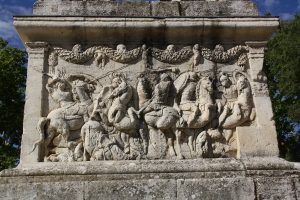
Relief on the Mausoleum of Glanum. Photo by Michel Gybels.
Henri Rolland was director of the excavations from 1942 to 1969, which progressed from north to south, i.e. from the forum to the sanctuary in the gorge. We owe this scholar also for the systematic publications, the surveys as well as the public exhibition of the many finds in the “Hotel de Sade” in Saint-Rémy-de-Provence.
The excavations have continued since 1982. A monumental well of the Hellenistic period has been discovered, Glanum’s southern district and the gate of the rampart and the foundations of a temple investigated.
Les Antiques
The mausoleum, a monumental tomb, is situated outside the northern entrance to the city. On the architrave facing the road is an inscribed dedication which tells us that “Sextus, Lucius and Marcus Julius, sons of Gaius, offered this tomb to their parents (SEX.L.M.IVLIEI.C.F.PARENTIBVS.SVEIS). It is likely that the two toga-wearing statues in the tholos at the top are the father and the eldest brother; the mother is not represented, which was normal at that time.
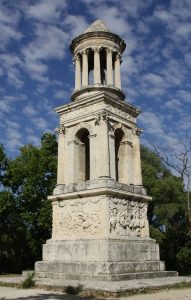
The mausoleum of Glanum. Photo by Michel Gybels.
The tholos is a circular dome in the Corinthian order, sheltering the effigies of two male togati, whose heads were replaced in the 18th century. The frieze is decorated by an ornamental rinceau (ornamental band featuring stylized vines with leaves). The conical roof is covered with scales, common in funeral art, though the ridge acroterion (a decorative stone object that crowned the building) is missing.
The second level consists of an arch with four bays in the Corinthian order (tetrapylon). The archivolts are decorated with acanthus leaves, symbols of perpetual rebirth, and a Gorgon’s head, the protector of the tomb, adorns the keystone.
The epitaph is engraved on the architrave on the north side. On the frieze, Tritons carry the solar disc above the ocean, keeping it away from marine monsters.
The arch is less well preserved than the mausoleum. Dating towards the end of Augustus’ reign (who died in AD 14) the arch is a symbol of Glanum’s municipal dignity and might testify to the status of Latin colony, which the city probably received in this period.
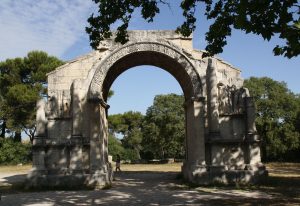
The monumental Arch. Photo by Michel Gybels.
The sculptures exalting the triumph of the victor and the “civilising” mission of the city. There are several panels depicting chained warriors and prisoners, representing defeated ennemies like a defeated Gaul.
Both monuments are situated on the side of the road and are free to visit (no charge).
The Excavations of the Ancient City
Opposite “The Antiques” is the road leading to the entrance of the ancient city. One reach first the visitor center where you can buy the entrance ticket and where is also a shop and a little overviewing exhibition of the site.
First one enters the residential quarter with the public baths, built around the 1st century BCE, modernised at the end of the 1st century AD and embellished with marble during the reign of Lucius Verus (161-169). There are a palaestra, frigidarium, laconicum, hypocausts and a caldarium. To the south is a large swimming pool.
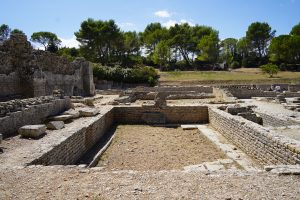
Swimming pool of the Baths. Photo by TimeTravelRome.
Between the baths and the basilica of the forum are the remains of a house with a Doric peristyle and the House of the Capricorn. The two mosaics of that house are now in the Hotel de Sade museum.
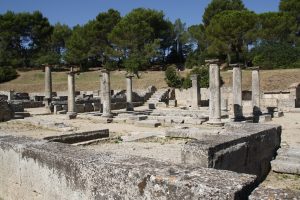
House with a Doric peristyle. Photo by Michel Gybels.
Further one reach the Hellenistic Market and the Bona Dea temple, an oracular goddess and assimilated to Cybele. Next the House of the Antae is a characteristic example of a Hellenistic Mediterranean house. Its rooms are distributed in three wings around a courtyard with basin surrounded by porticoes.
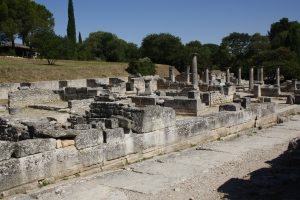
Houses along the main street of Glanum. Photo by Michel Gybels.
The House of Atys takes its name from a representation of Cybele’s lover on a marble relief that was found here. Its rooms are arranged around an impluvium, a small and shallow basin cantoned by four columns whose plinths are still preserved.
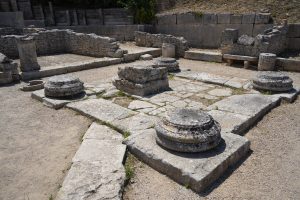
House of Atys. Photo by TimeTravelRome.
At the opposite hill are some viewpoints overlooking the monumental city centre. An enamel table shows the archaeological remains and illustrates the scale of the twin temples.
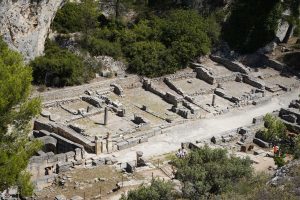
View from the hill on the sacred spring and the temple of Jupiter. Photo by TimeTravelRome.
At the monumental center, comprising four successive building phases from the 2nd century BCE to the 3rd century AD, are a lot of ancient remains of the city like a triumphal fountain, a Hellenistic fountain (?), a theatre (?), a public square, a building with two rooms, a council hall or bouleuterion, a Doric porticus, an exedra, statues of notable Glanices and ramparts.
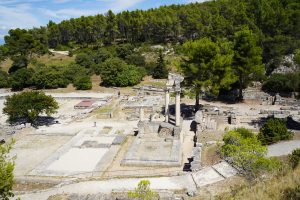
View from the hill on the monumental center of Glanum. Photo by TimeTravelRome.
There are also the remains of a Hellenistic town hall (?) and further away is the famous Dromos Well. The well (3 metres in diameter) dates from the late 2nd century BCE and its name derives from the 1,5 metre wide, thrice bent passageway or dromos with its 37 steps, which leads down to the water level, some 10 metres under the Hellenistic ground level.
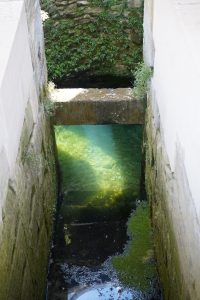
Clear water in the Dromos Well. Photo by TimeTravelRome.
On the way back from the well one reaches the side staircase and the demolished foundations of a small Tuscan temple.
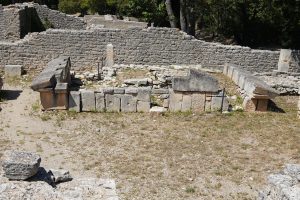
Remains of the Tuscan Temple. Photo by TimeTravelRome.
There are also remains of the courtyard houses (90-30 BCE), the house with the Two Alcoves, the house with Painted Coating and the house of Sulla.
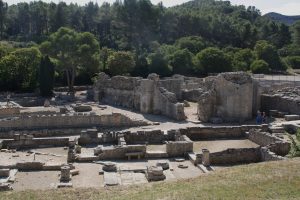
View on the House of Atys, Baths and Basilica. Photo by Michel Gybels.
The two Corinthian Twin Temples were built in the early years of Augustus’ reign (c. 20 BCE) and were part of the first forum.
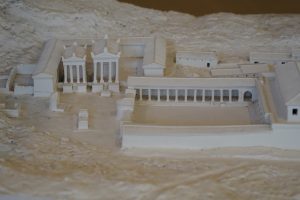
Reconstruction of the Forum and Twin Temples, in the Museum at the site of Glanum. Photo by TimeTravelRome.
A full description of all the other remains and monuments can be found in the beautiful illustrated guidebook “Glanum, from Salluvian Oppidum to Roman City”, available at the visitor centre in French, English and German.
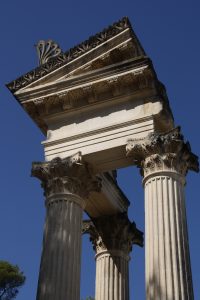
Partly reconstructed remains of the Twin Temples. Photo by Michel Gybels.
The Hotel de Sade in Saint-Rémy-de-Provence
The archaeological finds from Glanum are preserved in the Hotel de Sade in the centre of Saint-Rémy-de-Provence. It is a remarkable collection of architectural and figurative sculpture from Gallo-Greek and Gallo-Roman times.
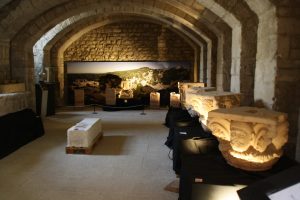
The view of the Hotel de Sade exhibition. Photo by Michel Gybels.
The Hotel de Sade comprises an ensemble of buildings and vestiges from different periods, which was acquired by the French government and listed in 1929. Jules Formigé and Henri Rolland’s excavations and the recent digs have uncovered vast 4th century public thermae, contemporary with the Thermes of Constantin in Arles (Arelate). These buildings were raised and reused in the Middle Ages.
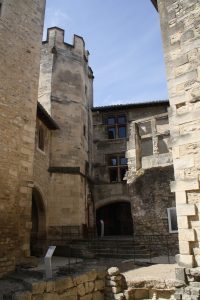
Medieval structures built on top of the ancient Baths. Photo by Michel Gybels.
The major renovation of the site (2004-2015) allows the visitor to explore two thousand years of history and temporary exhibitions featuring the collections discovered in Glanum and studies in a new research centre.
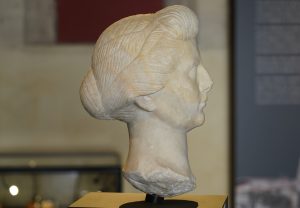
“Potrait of a princess” (Livia ?) exhibited in the Museum. Photo by TimeTravelRome.
Practical Information
The monuments of “Les Antiques” are free to visit next to the road that leads from Maussane -les-Alpilles to Saint-Rémy-de-Provence. There is also a parking lot.
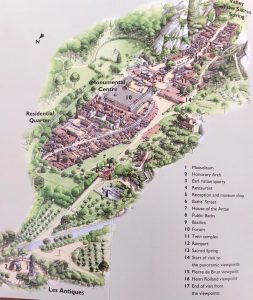
The map of the site of Glanum. Photo by Michel Gybels.
The archaeological site of Glanum is opposite “Les Antiques”, where you have to buy a ticket at the visitor centre. Open October to March from 10 am to 5 pm – April to September from 9.30 am to 6 pm. Closed on Mondays from October to March.
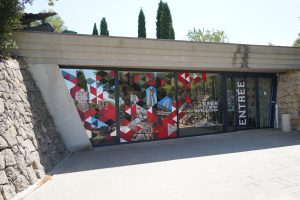
Museum of Glanum. Photo by TimeTravelRome.
The Hotel de Sade is situated at 1, rue du Parage in the centre of Saint-Rémy-de-Provence and is closed on Mondays.
Source: Guidebook “Glanum – from Salluvian Oppidum to Roman City”, available at the visitor centre of Glanum and in the Hotel de Sade.
Header photo: Les Antiques of Glanum, by TimeTravelRome


